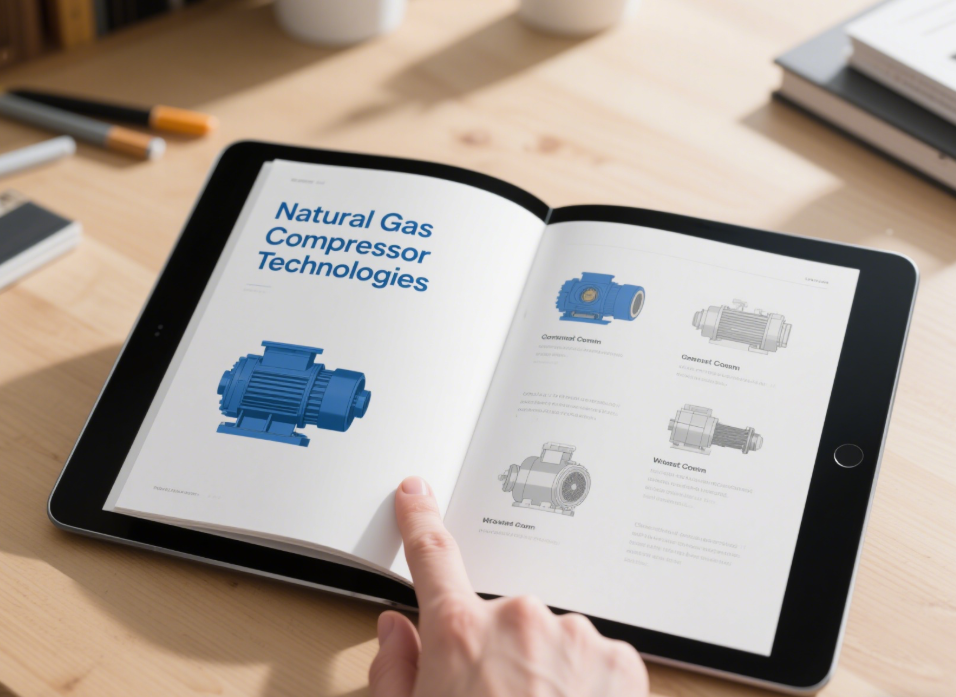Hey there, from your team at CMN Compressor! Natural gas is a powerhouse in our global energy mix, playing a vital role in everything from heating our homes to fueling industries. But to get this valuable resource where it needs to go and make it usable, we often need to give it a "boost" – and that's where natural gas compressors come into play.
The world of natural gas compression is diverse, with different technologies excelling in various scenarios. Understanding these types is crucial for anyone involved in the oil & gas sector, power generation, or even specialized applications like CNG. So, let's explore the main players in natural gas compression!

Before diving into the "how," let's quickly touch on the "why." Compressing natural gas serves several critical purposes:
Transportation: To move natural gas efficiently through long-distance pipelines, its pressure needs to be increased periodically at compressor stations.
Storage: Natural gas can be stored at high pressures in underground reservoirs or specialized tanks, requiring compression.
Processing: Many gas processing plants require specific pressures for operations like separating natural gas liquids (NGLs), dehydration, or sweetening (removing H2S).
Enhanced Recovery & Wellhead Operations: Boosting low-pressure gas from wells to meet pipeline pressure requirements or for gas lift and injection.
CNG (Compressed Natural Gas): For use as a vehicle fuel, natural gas must be compressed to very high pressures.
At CMN Compressor, we see firsthand how essential these machines are across the entire natural gas value chain.
Broadly speaking, natural gas compressors fall into two main categories based on their method of operation:
Positive Displacement Compressors: These machines work by trapping a fixed volume of gas in a chamber, then reducing the volume of that chamber to increase the gas pressure. Think of it like a bicycle pump.
Dynamic Compressors (often Centrifugal for NG): These use rotating impellers to accelerate the gas to a high velocity. This velocity energy is then converted into pressure energy in a diffuser.
The choice between these families often depends on the required flow rates and pressure ratios.
Let's get more specific and look at the workhorses within these families:
These are a classic example of positive displacement.
How they work: One or more pistons move back and forth within cylinders. Gas is drawn in during the suction stroke and compressed and discharged during the compression stroke. They can be single-acting (compressing on one side of the piston) or double-acting (compressing on both sides).
Best suited for: High pressures and variable flow rates. They are very common in gas gathering, gas lift, gas injection, storage, and CNG fueling stations.
Pros: Can achieve very high compression ratios per stage, efficient over a wide range of conditions.
Cons: Pulsating gas flow (may require dampeners), more moving parts leading to potentially higher maintenance.
Another type of positive displacement compressor:
How they work: Two intermeshing helical screws (rotors) trap and compress gas as they rotate. The volume of the pockets between the rotors and the casing decreases along the length of the screws, compressing the gas.
Best suited for: Medium pressures and flow rates. Often found in gas gathering, fuel gas boosting, and some processing applications. Can be oil-flooded (requiring oil separation) or, for specialized applications, oil-free.
Pros: Continuous, non-pulsating flow, compact design, good part-load efficiency.
Cons: Limited to moderate pressure ratios per casing compared to reciprocating units.
The most common type of dynamic compressor for natural gas.
How they work: Gas enters the eye of a rapidly rotating impeller and is thrown outwards by centrifugal force. This increases its velocity and pressure. Diffuser vanes then convert the velocity energy into additional pressure. Multi-stage units use several impellers in series to achieve higher pressures.
Best suited for: High to very high flow rates and continuous operation, such as in mainline pipeline transmission, LNG plants, and large gas processing facilities.
Pros: High reliability, smooth flow, can handle very large volumes, relatively low maintenance.
Cons: Less efficient at off-design (turndown) conditions, sensitive to changes in gas composition and molecular weight.
While these are the main types, variations and specialized designs exist. You can explore the range of solutions we supply at CMN Compressor.
Choosing the correct compressor isn't just about picking a type; it's about matching the technology to the specific demands of the application. Key factors include:
Required Flow Rate (Capacity): How much gas needs to be moved?
Suction and Discharge Pressures: What's the starting pressure, and what's the target pressure? This determines the compression ratio.
Gas Composition: Is it sweet or sour (containing H2S)? Wet or dry? The presence of corrosive elements or liquids drastically affects material selection and compressor design.
Efficiency & Operating Costs: Energy consumption is a major factor over the life of a compressor.
Footprint and Site Conditions: Space limitations, ambient conditions, and available utilities.
Reliability and Maintenance Requirements: Critical for minimizing downtime.
As you can see, the world of natural gas compressors is diverse, with each type offering unique advantages for specific tasks. From robust reciprocating units handling high pressures to mighty centrifugals moving vast quantities through pipelines, the right compressor is essential for efficient and reliable natural gas operations.
If you're navigating the complexities of selecting a natural gas compressor for your project, our team at CMN Compressor has the expertise to guide you. We're passionate about finding the optimal compression solution to meet your unique challenges. Don't hesitate to reach out!